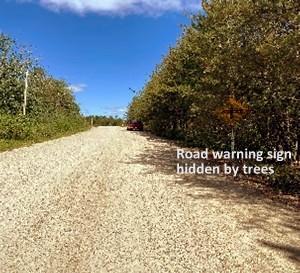
Safety talks and road maintenance help prevent severe injuries and fatalities
by Penny Ratushniak RPF, WSN Health and Safety Specialist
Hazard Alert: Collision on unprotected railway crossing – Download and share
In more rural and remote areas of Ontario, many railway crossings are unprotected and that means there are no control devices like barriers, alarms, or warning lights.
Last year, there were two serious railway crossing incidents. In the first incident, a haul truck leaving mill yard drove across a railway crossing where an oncoming train clipped the driver’s cab and smashed it aside. There was serious damage to the vehicle but fortunately the driver escaped without injury.
In the second incident, a haul truck driving over railway tracks was hit by an oncoming train and its trailer was dragged more than 50 metres down the track. The driver was not injured and said they did not see the train when they approached the crossing. There was extensive damage to the truck.
Recently, a senior forestry manager shared that they had stopped at the tracks, looked both ways, and proceeded over tracks, only then to see the train coming. They believe they didn’t see the train because they were distracted in deep thought and normally no train is present. Luckily, no incident occurred.
Avoid complacency on regular driving routes
We all know that travelling the same route day after day can lead to complacent behaviour behind the wheel. Complacency is a major cause of taking shortcuts that lead to near-misses, injuries, property damage, and fatalities. Sometimes it takes a significant unwanted event or self- realization to snap out of autopilot to avoid workplace incidents and potential injuries.
If you’re a driver working on forest access roads or mill yards with railway crossings, you must stay alert of the location and be aware of the hazards that go with railway crossings. Always follow the safe work procedures at railway crossings and always be alert to where you are in relation to the crossing. Staying aware of surroundings is key and keep your state of mind on the task so that complacency does not steal your focus.
Road maintenance is key to ensuring visible signage and line of sight
| Sign visibility ok, but vegetation could be trimmed. |
Regular and routine road and yard maintenance near railway crossings can help ensure drivers are alert and aware of the hazards. This will help reduce near-misses and incidents at railway crossings. Active logging and hauling on forestry access roads require regular road maintenance that includes proper grading, dust control, sanding, roadside vegetation control, and proper signage.
Inventory of unprotected crossings: Many railway crossings on forest access roads and in mill yards are unprotected crossings, meaning they do not have any control devices such as alarms, warning lights or cross arms. As part of the road maintenance program, an inventory of all railway crossings should be taken. Mature trees adjacent to the railway tracks may obstruct the view of the line-of-sight and force drivers to inch up closer to tracks unnecessarily. For mill yards, ensure railway crossing are included in your yard management plan.
| Faded stop sign at side of road. |
Prominent signage: Roadside vegetation control must be monitored annually to ensure these warning signs are still highly visible to drivers. Warning signs are there to remind drivers to start slowing down. In addition to roadside vegetation control, ensure vegetation is low at either side of the crossing allowance. This will increase drivers’ awareness of hazards and will improve their line of sight at each approach.Once this inventory is taken, proper warning signage of “Railway Crossing Ahead” should be erected on both sides of upcoming crossings and at a distance far enough for any vehicle to slow down comfortably to stop at the crossing.
What the law says
Ontario legislation for Industrial Regulation 851, Section 117(c):
117. A haul road shall,
(c) have signs warning of the approach to every
(i) bridge,
(ii) crossroad,
(iii) blind curve,
(iv) steep grade, and
(v) railway crossing.
Tips when approaching a railway crossing
- Communicate often and have regular safety talks to keep drivers alert about railway crossings
- Review Safe Work Practices or mill yard management plans for railway crossing safety
- Adhere to advanced warning signs of railway crossing by slowing down – if they are not there or not visible make aware to who is responsible for roads maintenance
- Ensure stop signs are visibly bright and not faded at each crossing
- Come to a complete stop at least five metres before the nearest rail. Do not inch-up or creep over the tracks. STOP! Then listen and look both ways for oncoming trains
- Use extra caution during glare of sunrise or sunset
- Do not cross the track until you are sure there are no trains approaching
- Never race a train and cross the tracks just ahead of it – a train can take up to two km to come to a complete stop and it takes a haul truck at least 15 seconds to go over a set of tracks
- Never stop on the tracks
- If your vehicle does get stuck on the tracks and a train is approaching, get out of vehicle immediately, move to a safe location and contact authorities
- Work with railway company to ensure the railway safety features and signage are following site requirements for compliance
- Continuously do a complacency self-check
Be alert, slow down and expect to encounter a train at every crossing.
Travelling on forest access roads and in mill yards with unprotected railway crossings requires attentive drivers, and a proactive roads and yards management plan.
For more information, contact Penny Ratushniak.
Penny Ratushniak is a Health and Safety Specialist for Workplace Safety North and is based out of Dryden serving Atikokan to the Ontario-Manitoba border. She is a Register Professional Forester and Canadian Registered Safety Professional. Penny’s industry background allows her to assess the needs of various forestry businesses including tree plant, harvest and mill operations. In addition, to forestry Penny, works closely with many other local businesses in the north helping with health and safety programs and training needs.
Related
Industry experts analyze causes of distracted driving on the job
Northern Ontario forest agency adopts BC-legislated road sign program
Tips for safe winter driving on logging roads
Implementing a safe driving program in your workplace - free information package
Safe Workplace Ontario – third-party health and safety designation program for Ontario businesses
Leading practices for traffic management
Training




